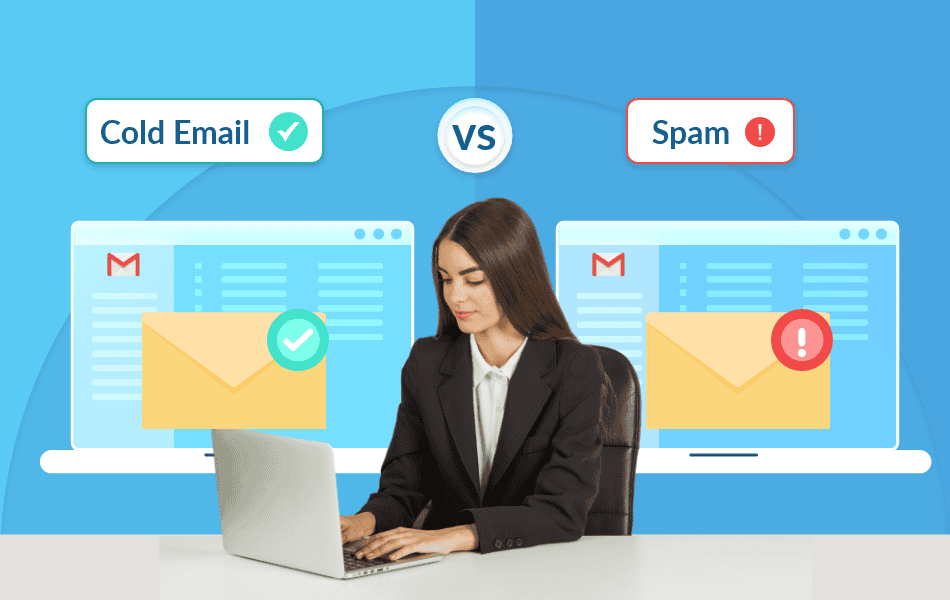Subscribe to Our Newsletter
Stay updated with the latest tips and strategies. Get additional discounts and alerts on offers.

Cold emailing and spam are two terms that are often used interchangeably in the world of email communication. Though they might seem similar — like two peas in a pod — they are as different as night and day. This article aims to dissect the concept of cold email vs spam — helping you navigate this gray area for successful email marketing!
Cold email is similar to shaking hands and introducing yourself at a business conference — you have not interacted with the other person, but it is clear that you are reaching out to establish a connection for a possible business deal proposal or a sales pitch, in the future. The intent here is clear and up to the point.
Another example to explain cold emails is a thoughtful guest who brings a bottle of wine to a dinner party, keeping in mind the host’s taste — you seek to add value to their evening while benefiting from a good time yourself.
A key aspect worthy of mention in the subject of cold email vs spam, is the way the recipients’ email addresses are obtained for sending them emails. Recipient addresses for cold emails are sourced by surfing online for prospects who have high chances of benefiting from your offering. Common email-finding tools to find email addresses of prospects are Voila Norbert, Uplead, Clearout and Clearbit.
Another effective and effortless way to gather valid, verified, relevant and legitimate email addresses of your target audience is purchasing databases from DataCaptive — a reliable B2B database provider, offering 95% accurate contact information of prospective clients who have consented to receive marketing communication from you! Now, when it comes to spam emails, email addresses of recipients are purchased illegally or through bots that compile lists of random email addresses that might or might not be functional, from the internet. Spam emails almost always end up in the spam folder and have high email bounce rates.
The line that divides a cold email from spam is as thin as paper but as significant as the Great Wall of China — which we are sure you are aware of by now. This brings us to the next part of this article — what are the best cold email practices to incorporate in your email marketing campaign for guaranteed success?
Now that you understand the concept of cold email vs spam, let us move on to navigating the legal landscape of email marketing, which is risky and demands utmost attention and awareness of laws and regulations governing email communication — which are constantly being updated and added. Non-adherence to such laws and regulations can land you in serious legal trouble!
Read ahead to find out what the two of the most important email communication laws and regulations mean.
Navigating the gray area of email marketing requires a keen eye for avoiding the mistakes that can cause spam triggers — sending your email directly to the spam folder, never to be seen by your target audience. Understanding cold email vs spam is not enough, one must learn how to avoid spam triggers to ensure that an email reaches its right destination.
Misleading Subject Lines-
Overusing Sales Language-
Excessive Use of Caps and Exclamation Points-
Spammy Words and Phrases-
Using Too Many Images or Big Images-
Colorful Fonts and Bad HTML Coding-
Failing to Include a Physical Address-
Failure to Include an Opt-out Link-
Understanding the cold email vs spam is vital. While one represents a targeted, respectful approach to nurturing new connections and presenting mutually beneficial opportunities, the other is a scattergun approach that’s not just ineffective but illegal and harmful to one’s reputation and business. By complying with email best practices, personalizing your approach, and constantly aiming to add value, cold emailing can be a powerful tool in your email marketing journey. Be a welcome guest rather than an unwelcome pest!
Show Some Love!

Subscribe to Our Newsletter
Stay updated with the latest tips and strategies. Get additional discounts and alerts on offers.
Related Articles
Subscribe to Newsletter
Stay up to date with the latest marketing, sales, and service tips and news.
